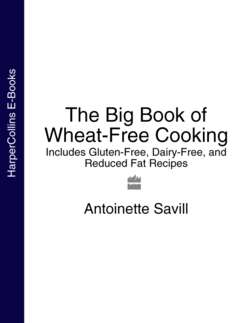Читать книгу The Big Book of Wheat-Free Cooking: Includes Gluten-Free, Dairy-Free, and Reduced Fat Recipes - Antoinette Savill, Antoinette Savill - Страница 5
Becoming Wheat-Free
ОглавлениеThe buzzword for the future is wheat-watching. In countries such as the UK, Australia and the USA, the trend has already begun, with growing numbers of people avoiding wheat, either permanently or for short periods, to improve their health and energy.
However, when it comes to putting it into practice, the decision to go wheat free can be a little more difficult than one might think – not just because of the countless wheat-based products such as breads, pastas, pastries, cakes and cookies that are on the market but also because so many other products may surreptitiously contain wheat. You may be surprised to find that wheat is used to bulk out or stabilize many foods. For instance, nearly all processed, frozen or canned foods contain wheat, including soups, mayonnaise, sausages and frozen French fries. In addition, many manufactured products, such as soy sauce, contain very small amounts of wheat. Such tiny quantities may not cause problems for most people but those who have a wheat allergy or coeliac disease must ensure that everything they eat is entirely wheat free.
It’s all too easy to dwell on the negative effects that some foods can have on us but we mustn’t forget that food can act as a very healing medicine. It is vital then that we stop and consider what we are putting into our bodies and what effect it has on us physically and emotionally before we charge gung ho round the supermarket, throwing anything in our trolley.
Thankfully shopping has become a less arduous task for wheat-watchers over recent years, as an increasing number of wheat-free ingredients and products have become available. Take a look in the ‘well-being’ and organic aisles, for instance, and you’ll find lots of interesting new wheat-free products from all over the world. Alternatively, you can buy the foods and ingredients that you need from health food shops, by mail order or on the internet (you’ll find a helpful list of stockists here).
Thanks to chefs like Jamie Oliver, cooking is now tremendously popular again – even amongst the young, many of whom are seeing it as cool for the first time. The TV food programs portray the fun and excitement of cooking and I want to show that cooking for food intolerance needn’t be any different. The recipes in this book will ensure that cooking is an enjoyable experience – no matter what your age or level of experience.
With today’s fast pace of life, shared family meals have inevitably become rare. Lifestyle changes and busy schedules mean that TV dinners and the general ‘grab and graze’ culture have become part of our way of looking at food and cooking it. However, I hope that the selection of quick, easy and comforting recipes in this book will encourage a return to everyone congregating in the kitchen and helping to prepare a delicious meal, as well as chatting and dining together.
My aim with this book is to provide plenty of delicious alternatives to products that normally contain wheat. You will therefore find the pages packed with wonderful breads, muffins, cakes, desserts and pies made with a wide variety of nutritious cereals such as rye, barley, oatmeal, rice, corn, millet and quinoa. And so that you can enjoy life to the full and not miss any of the normal foods that we eat on a day-to-day basis, I have also included many recipes that can be enjoyed by your family, your friends or at work – those who don’t suffer from intolerances won’t know the difference!
Improved health is the usual objective of those cutting out wheat – but it can have other advantages too. Wheat intolerance can be an important factor in a failure to shed excess weight. If you are eating a balanced diet and are in relatively good health yet still have difficulty losing weight, it may be that food intolerance is playing a part. This is because food intolerance can encourage the body to hold on to excess fluid. When the offending food is removed, weight loss often occurs. Abdominal bloating is often a sign that the digestive system is not dealing very well with a specific food and the most common food that is known to cause this problem is wheat.
